Platelet and Red Blood Cell Volume Indices in Patients with Rheumatoid Arthritis: A Systematic Review and Meta-Analysis
Abstract
:1. Introduction
2. Materials and Methods
2.1. Search Strategy and Study Selection
2.2. Statistical Analysis
3. Results
3.1. Systematic Search
3.2. Mean Platelet Volume (MPV)
3.2.1. Study Characteristics
3.2.2. Risk of Bias
3.2.3. Results of Individual Studies and Syntheses
3.2.4. Publication Bias
3.2.5. Subgroup and Meta-Regression Analysis
3.2.6. Certainty of Evidence
3.3. Platelet Distribution Width (PDW)
3.3.1. Study Characteristics
3.3.2. Publication Bias
3.3.3. Results of Individual Studies and Syntheses
3.3.4. Publication Bias
3.3.5. Subgroup and Meta-Regression Analysis
3.3.6. Certainty of Evidence
3.4. Red Blood Cell Distribution Width (RDW)
3.4.1. Study Characteristics
3.4.2. Risk of Bias
3.4.3. Results of Individual Studies and Syntheses
3.4.4. Publication Bias
3.4.5. Subgroup and Meta-Regression Analysis
3.4.6. Certainty of Evidence
4. Discussion
5. Conclusions
Supplementary Materials
Author Contributions
Funding
Institutional Review Board Statement
Informed Consent Statement
Data Availability Statement
Conflicts of Interest
References
- Silman, A.J.; Pearson, J.E. Epidemiology and genetics of rheumatoid arthritis. Arthritis Res. 2002, 4 (Suppl. S3), S265–S272. [Google Scholar] [CrossRef] [PubMed] [Green Version]
- Alamanos, Y.; Voulgari, P.V.; Drosos, A.A. Incidence and prevalence of rheumatoid arthritis, based on the 1987 American College of Rheumatology criteria: A systematic review. Semin. Arthritis Rheum. 2006, 36, 182–188. [Google Scholar] [CrossRef] [PubMed]
- Aletaha, D.; Neogi, T.; Silman, A.J.; Funovits, J.; Felson, D.T.; Bingham, C.O., 3rd; Birnbaum, N.S.; Burmester, G.R.; Bykerk, V.P.; Cohen, M.D.; et al. 2010 Rheumatoid arthritis classification criteria: An American College of Rheumatology/European League Against Rheumatism collaborative initiative. Arthritis Rheum. 2010, 62, 2569–2581. [Google Scholar] [CrossRef] [PubMed]
- Nakken, B.; Papp, G.; Bosnes, V.; Zeher, M.; Nagy, G.; Szodoray, P. Biomarkers for rheumatoid arthritis: From molecular processes to diagnostic applications-current concepts and future perspectives. Immunol. Lett. 2017, 189, 13–18. [Google Scholar] [CrossRef] [PubMed]
- Shapiro, S.C. Biomarkers in Rheumatoid Arthritis. Cureus 2021, 13, e15063. [Google Scholar] [CrossRef]
- Kolarz, B.; Podgorska, D.; Podgorski, R. Insights of rheumatoid arthritis biomarkers. Biomarkers 2021, 26, 185–195. [Google Scholar] [CrossRef]
- Nell, V.P.; Machold, K.P.; Stamm, T.A.; Eberl, G.; Heinzl, H.; Uffmann, M.; Smolen, J.S.; Steiner, G. Autoantibody profiling as early diagnostic and prognostic tool for rheumatoid arthritis. Ann. Rheum. Dis. 2005, 64, 1731–1736. [Google Scholar] [CrossRef]
- Nishimura, K.; Sugiyama, D.; Kogata, Y.; Tsuji, G.; Nakazawa, T.; Kawano, S.; Saigo, K.; Morinobu, A.; Koshiba, M.; Kuntz, K.M.; et al. Meta-analysis: Diagnostic accuracy of anti-cyclic citrullinated peptide antibody and rheumatoid factor for rheumatoid arthritis. Ann. Intern. Med. 2007, 146, 797–808. [Google Scholar] [CrossRef]
- Vander Cruyssen, B.; Peene, I.; Cantaert, T.; Hoffman, I.E.; De Rycke, L.; Veys, E.M.; De Keyser, F. Anti-citrullinated protein/peptide antibodies (ACPA) in rheumatoid arthritis: Specificity and relation with rheumatoid factor. Autoimmun. Rev. 2005, 4, 468–474. [Google Scholar] [CrossRef]
- Yamane, T.; Hashiramoto, A.; Tanaka, Y.; Tsumiyama, K.; Miura, Y.; Shiozawa, K.; Chihara, K.; Shiozawa, S. Easy and accurate diagnosis of rheumatoid arthritis using anti-cyclic citrullinated peptide 2 antibody, swollen joint count, and C-reactive protein/rheumatoid factor. J. Rheumatol. 2008, 35, 414–420. [Google Scholar]
- Sokka, T.; Pincus, T. Erythrocyte sedimentation rate, C-reactive protein, or rheumatoid factor are normal at presentation in 35%–45% of patients with rheumatoid arthritis seen between 1980 and 2004: Analyses from Finland and the United States. J. Rheumatol. 2009, 36, 1387–1390. [Google Scholar] [CrossRef] [PubMed]
- Erre, G.L.; Paliogiannis, P.; Castagna, F.; Mangoni, A.A.; Carru, C.; Passiu, G.; Zinellu, A. Meta-analysis of neutrophil-to-lymphocyte and platelet-to-lymphocyte ratio in rheumatoid arthritis. Eur. J. Clin. Investig. 2019, 49, e13037. [Google Scholar] [CrossRef] [PubMed] [Green Version]
- Biljak, V.R.; Pancirov, D.; Cepelak, I.; Popovic-Grle, S.; Stjepanovic, G.; Grubisic, T.Z. Platelet count, mean platelet volume and smoking status in stable chronic obstructive pulmonary disease. Platelets 2011, 22, 466–470. [Google Scholar] [CrossRef]
- Karbiner, M.S.; Sierra, L.; Minahk, C.; Fonio, M.C.; Bruno, M.P.; Jerez, S. The role of oxidative stress in alterations of hematological parameters and inflammatory markers induced by early hypercholesterolemia. Life Sci. 2013, 93, 503–508. [Google Scholar] [CrossRef]
- Korniluk, A.; Koper-Lenkiewicz, O.M.; Kaminska, J.; Kemona, H.; Dymicka-Piekarska, V. Mean Platelet Volume (MPV): New Perspectives for an Old Marker in the Course and Prognosis of Inflammatory Conditions. Mediat. Inflamm. 2019, 2019, 9213074. [Google Scholar] [CrossRef] [PubMed] [Green Version]
- Salvagno, G.L.; Sanchis-Gomar, F.; Picanza, A.; Lippi, G. Red blood cell distribution width: A simple parameter with multiple clinical applications. Crit. Rev. Clin. Lab. Sci. 2015, 52, 86–105. [Google Scholar] [CrossRef]
- Marzouk, H.; Mostafa, N.; Khalifa, I.; Badawi, N.; Mohamed Fathy Sabry, N.I. Red Cell Distribution Width (RDW) as a Marker of Subclinical Inflammation in Children with Familial Mediterranean Fever. Curr. Rheumatol. Rev. 2020, 16, 298–303. [Google Scholar] [CrossRef] [PubMed]
- Moola, S.; Munn, Z.; Tufanaru, C.; Aromataris, E.; Sears, K.; Sfetcu, R.; Currie, M.; Qureshi, R.; Mattis, P.; Lisy, K.; et al. Systematic reviews of etiology and risk. In Joanna Briggs Institute Reviewer’s Manual; Aromataris, E., Munn, Z., Eds.; Johanna Briggs Institute: Adelaide, SA, Australia, 2017. [Google Scholar]
- Balshem, H.; Helfand, M.; Schunemann, H.J.; Oxman, A.D.; Kunz, R.; Brozek, J.; Vist, G.E.; Falck-Ytter, Y.; Meerpohl, J.; Norris, S.; et al. GRADE guidelines: 3. Rating the quality of evidence. J. Clin. Epidemiol. 2011, 64, 401–406. [Google Scholar] [CrossRef]
- Page, M.J.; McKenzie, J.E.; Bossuyt, P.M.; Boutron, I.; Hoffmann, T.C.; Mulrow, C.D.; Shamseer, L.; Tetzlaff, J.M.; Akl, E.A.; Brennan, S.E.; et al. The PRISMA 2020 statement: An updated guideline for reporting systematic reviews. BMJ 2021, 372, n71. [Google Scholar] [CrossRef]
- Hozo, S.P.; Djulbegovic, B.; Hozo, I. Estimating the mean and variance from the median, range, and the size of a sample. BMC Med. Res. Methodol. 2005, 5, 13. [Google Scholar] [CrossRef] [Green Version]
- Wan, X.; Wang, W.; Liu, J.; Tong, T. Estimating the sample mean and standard deviation from the sample size, median, range and/or interquartile range. BMC Med. Res. Methodol. 2014, 14, 135. [Google Scholar] [CrossRef] [PubMed]
- Deeks, J.J.; Higgins, J.P.T.; Altman, D.G. Analysing data and undertaking meta-analyses. In Cochrane Handbook for Systematic Reviews of Interventions; Higgins, J.P.T., Thomas, J., Chandler, J., Cumpston, M., Li, T., Page, M.J., Welch, V.A., Eds.; John Wiley & Sons: Chichester, UK, 2021. [Google Scholar]
- Tobias, A. Assessing the influence of a single study in the meta-analysis estimate. Stata Tech. Bull. 1999, 47, 15–17. [Google Scholar]
- Begg, C.B.; Mazumdar, M. Operating characteristics of a rank correlation test for publication bias. Biometrics 1994, 50, 1088–1101. [Google Scholar] [CrossRef] [PubMed]
- Sterne, J.A.; Egger, M. Funnel plots for detecting bias in meta-analysis: Guidelines on choice of axis. J. Clin. Epidemiol. 2001, 54, 1046–1055. [Google Scholar] [CrossRef]
- Duval, S.; Tweedie, R. Trim and fill: A simple funnel-plot-based method of testing and adjusting for publication bias in meta-analysis. Biometrics 2000, 56, 455–463. [Google Scholar] [CrossRef]
- Kisacik, B.; Tufan, A.; Kalyoncu, U.; Karadag, O.; Akdogan, A.; Ozturk, M.A.; Kiraz, S.; Ertenli, I.; Calguneri, M. Mean platelet volume (MPV) as an inflammatory marker in ankylosing spondylitis and rheumatoid arthritis. Jt. Bone Spine 2008, 75, 291–294. [Google Scholar] [CrossRef]
- Jurcut, C.; Jurcut, R.; Caraiola, S.; Nitescu, D.; Mihai, C.; Baicus, A.; Copaci, I.; Predeteanu, D.; Ginghina, C.; Tanasescu, C. Platelet histogram indices and cardiovascular disease in patients with rheumatoid arthritis. Rom. J. Intern. Med. 2010, 48, 51–55. [Google Scholar]
- Yazici, S.; Yazici, M.; Erer, B.; Erer, B.; Calik, Y.; Ozhan, H.; Ataoglu, S. The platelet indices in patients with rheumatoid arthritis: Mean platelet volume reflects disease activity. Platelets 2010, 21, 122–125. [Google Scholar] [CrossRef]
- Isik, M.; Sahin, H.; Huseyin, E. New platelet indices as inflammatory parameters for patients with rheumatoid arthritis. Eur. J. Rheumatol. 2014, 1, 144–146. [Google Scholar] [CrossRef]
- Yilldirim, A.; Karabiber, M.; Surucu, G.D.; Turkbeyler, I.H.; Karakoyun, A.; Selkuc, M.Y.; Zengin, O. The changes of mean platelet volume and platelet distribution width in patients with rheumatoid arthritis and their correlation with disease activity. Acta Med. Mediterr. 2015, 31, 1105–1111. [Google Scholar]
- Cakir, L.; Aktas, G.; Marcimek, O.B.; Enginyurt, O.; Kaya, Y.; Mercimek, K. Are Red Cell Distribution Width and Mean Platelet Volume associated with Rheumatoid Arthritis? Biomed. Res. 2016, 27, 292–294. [Google Scholar]
- Gökmen, F.; Akbal, A.; Reşorlu, H.; Binnetoğlu, E.; Cevizci, S.; Gökmen, E.; Köse, M.; Türkyılmaz, A.; Akbal, E. Mean Platelet Volume and Neutrophil Lymphocyte Ratio as Related to Inflammation Markers and Anti-CCP in Rheumatoid Arthritis. Aktuelle Rheumatol. 2014, 41, 488–491. [Google Scholar] [CrossRef] [Green Version]
- Tecer, D.; Sezgin, M.; Kanik, A.; Incel, N.A.; Cimen, O.B.; Bicer, A.; Sahin, G. Can mean platelet volume and red blood cell distribution width show disease activity in rheumatoid arthritis? Biomark. Med. 2016, 10, 967–974. [Google Scholar] [CrossRef] [PubMed]
- Du, J.; Chen, S.; Shi, J.; Zhu, X.; Ying, H.; Zhang, Y.; Chen, S.; Shen, B.; Li, J. The association between the lymphocyte-monocyte ratio and disease activity in rheumatoid arthritis. Clin. Rheumatol. 2017, 36, 2689–2695. [Google Scholar] [CrossRef]
- Talukdar, M.; Barui, G.; Adhikari, A.; Karmakar, R.; Ghosh, U.C.; Das, T.K. A Study on Association between Common Haematological Parameters and Disease Activity in Rheumatoid Arthritis. J. Clin. Diagn. Res. 2017, 11, EC01–EC04. [Google Scholar] [CrossRef] [PubMed]
- Al-Rawi, Z.S.; Gorial, F.I.; Al-Bayati, A.A. Red Cell Distribution Width in Rheumatoid arthritis. Mediterr. J. Rheumatol. 2018, 29, 38–42. [Google Scholar] [CrossRef]
- Illeez, O.G.; Ozkan, F.U.; Aktas, I. Parameters of total blood count; might they be indicators of inflammation in rheumatoid arthritis and ankylosing spondylitis? Acta Med. Mediterr. 2018, 34, 1751–1756. [Google Scholar] [CrossRef]
- Lin, F.; Wang, X.; Liang, Y.; Liu, D.; Zhang, Y.; Zhong, R.; Yang, Z. Red Blood Cell Distribution Width in Rheumatoid Arthritis, Ankylosing Spondylitis and Osteoarthritis: True Inflammatory Index or Effect of Anemia? Ann. Clin. Lab. Sci. 2018, 48, 301–307. [Google Scholar]
- Sag, S.; Sag, M.S.; Tekeoglu, I.; Kamanli, A.; Nas, K.; Acar, B.A. Relationship of hematologic markers with IL-17 and IL-1 beta in patients with rheumatoid arthritis. J. Back Musculoskelet. Rehabil. 2018, 31, 703–707. [Google Scholar] [CrossRef]
- Yang, W.M.; Zhang, W.H.; Ying, H.Q.; Xu, Y.M.; Zhang, J.; Min, Q.H.; Huang, B.; Lin, J.; Chen, J.J.; Wang, X.Z. Two new inflammatory markers associated with disease activity score-28 in patients with rheumatoid arthritis: Albumin to fibrinogen ratio and C-reactive protein to albumin ratio. Int. Immunopharmacol. 2018, 62, 293–298. [Google Scholar] [CrossRef]
- Khodashahi, M.; Saadati, N.; Rezaieyazdi, Z.; Sahebari, M.; Saremi, Z. Evaluation of Mean Platelet Volume in Patients with Rheumatoid Arthritis and its Relation with Severity of Disease. Rheumatol. Res. 2019, 4, 121–126. [Google Scholar] [CrossRef]
- Koca, T.T.; Arslan, A.; Çiledağ Özdemir, F.; Berk, E. The importance of red cell distribution width and neutrophil-lymphocyte ratio as a new biomarker in rheumatoid arthritis. Eur. Res. J. 2018, 5, 98–103. [Google Scholar] [CrossRef] [Green Version]
- Turgay Yildirim, O.; Gonullu, E.; Aydin, F.; Aksit, E.; Huseyinoglu Aydin, A.; Dagtekin, E. Nocturnal blood pressure dipping is similar in rheumatoid arthritis patients as compared to a normal population. Z. Rheumatol. 2019, 78, 190–194. [Google Scholar] [CrossRef] [PubMed]
- Khaled, S.A.A.; NasrEldin, E.; Makarem, Y.S.; Mahmoud, H.F.F. Value of Platelet Distribution Width and Mean Platelet Volume in Disease Activity Score of Rheumatoid Arthritis. J. Inflamm. Res. 2020, 13, 595–606. [Google Scholar] [CrossRef] [PubMed]
- Balbaloglu, O.; Ozcan, S.S. Is pentraxin 3 level an effective biomarker in disease activity in patients with rheumatoid arthritis? Arch. Med. Sci. 2020, 16, 81–86. [Google Scholar] [CrossRef]
- Dervisevic, A.; Muhic, A.; Zaciragic, A.; Fajkic, A.; Dervisevic, L.; Hasanbegovic, I.; Lepara, O.; Galijasevic, M. Red blood cell distribution width-to-platelet ratio inversely correlates with indicators of disease activity status in rheumatoid arthritis patients. Rom. J. Intern. Med. 2021, 59, 180–186. [Google Scholar] [CrossRef] [PubMed]
- Tan, L.; Gong, Y.; Zhang, Q.; Zhang, H.; Lu, X.; Huang, H. Clinical Value of Detecting Anti-Mutated Citrullinated Vimentin, Anti-Cyclic Citrullinated Peptide, Red Cell Distribution Width and 25-Hydroxyvitamin D in the Diagnosis of Rheumatoid Arthritis. Lab. Med. 2021, 52, 80–85. [Google Scholar] [CrossRef]
- Taha, S.I.; Samaan, S.F.; Ibrahim, R.A.; Moustafa, N.M.; El-Sehsah, E.M.; Youssef, M.K. Can Complete Blood Count Picture Tell Us More About the Activity of Rheumatological Diseases? Clin. Med. Insights Arthritis Musculoskelet. Disord. 2022, 15. [Google Scholar] [CrossRef]
- Cohen, J. Statistical Power Analysis for the Behavioral Sciences, 2nd ed.; Erlbaum: Hillsdale, NJ, USA, 1988. [Google Scholar]
- Paliogiannis, P.; Zinellu, A.; Mangoni, A.A.; Capobianco, G.; Dessole, S.; Cherchi, P.L.; Carru, C. Red blood cell distribution width in pregnancy: A systematic review. Biochem. Med. 2018, 28, 030502. [Google Scholar] [CrossRef]
- Zinellu, A.; Mangoni, A.A. Red Blood Cell Distribution Width, Disease Severity, and Mortality in Hospitalized Patients with SARS-CoV-2 Infection: A Systematic Review and Meta-Analysis. J. Clin. Med. 2021, 10, 286. [Google Scholar] [CrossRef]
- Dettori, P.; Paliogiannis, P.; Pascale, R.M.; Zinellu, A.; Mangoni, A.A.; Pintus, G. Blood Cell Count Indexes of Systemic Inflammation in Carotid Artery Disease: Current Evidence and Future Perspectives. Curr. Pharm. Des. 2021, 27, 2170–2179. [Google Scholar] [CrossRef] [PubMed]
- Ford, J. Red blood cell morphology. Int. J. Lab. Hematol. 2013, 35, 351–357. [Google Scholar] [CrossRef] [PubMed]
- Williams, R.A.; Samson, D.; Tikerpae, J.; Crowne, H.; Gumpel, J.M. In-vitro studies of ineffective erythropoiesis in rheumatoid arthritis. Ann. Rheum. Dis. 1982, 41, 502–507. [Google Scholar] [CrossRef] [PubMed] [Green Version]
- Dinant, H.J.; de Maat, C.E. Erythropoiesis and mean red-cell lifespan in normal subjects and in patients with the anaemia of active rheumatoid arthritis. Br. J. Haematol. 1978, 39, 437–444. [Google Scholar] [CrossRef]
- Gangat, N.; Wolanskyj, A.P. Anemia of chronic disease. Semin. Hematol. 2013, 50, 232–238. [Google Scholar] [CrossRef] [PubMed]
- Maury, C.P.; Andersson, L.C.; Teppo, A.M.; Partanen, S.; Juvonen, E. Mechanism of anaemia in rheumatoid arthritis: Demonstration of raised interleukin 1 beta concentrations in anaemic patients and of interleukin 1 mediated suppression of normal erythropoiesis and proliferation of human erythroleukaemia (HEL) cells in vitro. Ann. Rheum. Dis. 1988, 47, 972–978. [Google Scholar] [CrossRef] [PubMed]
- Reid, C.D.; Prouse, P.J.; Baptista, L.C.; Gumpel, J.M.; Chanarin, I. The mechanism of the anaemia in rheumatoid arthritis: Effects of bone marrow adherent cells and of serum on in-vitro erythropoiesis. Br. J. Haematol. 1984, 58, 607–615. [Google Scholar] [CrossRef]
- Paulson, R.F.; Hariharan, S.; Little, J.A. Stress erythropoiesis: Definitions and models for its study. Exp. Hematol. 2020, 89, 43–54.e42. [Google Scholar] [CrossRef]
- Theurl, I.; Hilgendorf, I.; Nairz, M.; Tymoszuk, P.; Haschka, D.; Asshoff, M.; He, S.; Gerhardt, L.M.; Holderried, T.A.; Seifert, M.; et al. On-demand erythrocyte disposal and iron recycling requires transient macrophages in the liver. Nat. Med. 2016, 22, 945–951. [Google Scholar] [CrossRef]
- Ogdie, A.; Grewal, S.K.; Noe, M.H.; Shin, D.B.; Takeshita, J.; Chiesa Fuxench, Z.C.; Carr, R.M.; Gelfand, J.M. Risk of Incident Liver Disease in Patients with Psoriasis, Psoriatic Arthritis, and Rheumatoid Arthritis: A Population-Based Study. J. Investig. Dermatol. 2018, 138, 760–767. [Google Scholar] [CrossRef] [Green Version]
- Rodriguez-Carrio, J.; Alperi-Lopez, M.; Lopez, P.; Alonso-Castro, S.; Ballina-Garcia, F.J.; Suarez, A. Red cell distribution width is associated with cardiovascular risk and disease parameters in rheumatoid arthritis. Rheumatology 2015, 54, 641–646. [Google Scholar] [CrossRef] [PubMed] [Green Version]
- Bellan, M.; Soddu, D.; Zecca, E.; Croce, A.; Bonometti, R.; Pedrazzoli, R.; Sola, D.; Rigamonti, C.; Castello, L.M.; Avanzi, G.C.; et al. Association between red cell distribution width and response to methotrexate in rheumatoid arthritis. Reumatismo 2020, 72, 16–20. [Google Scholar] [CrossRef] [PubMed]
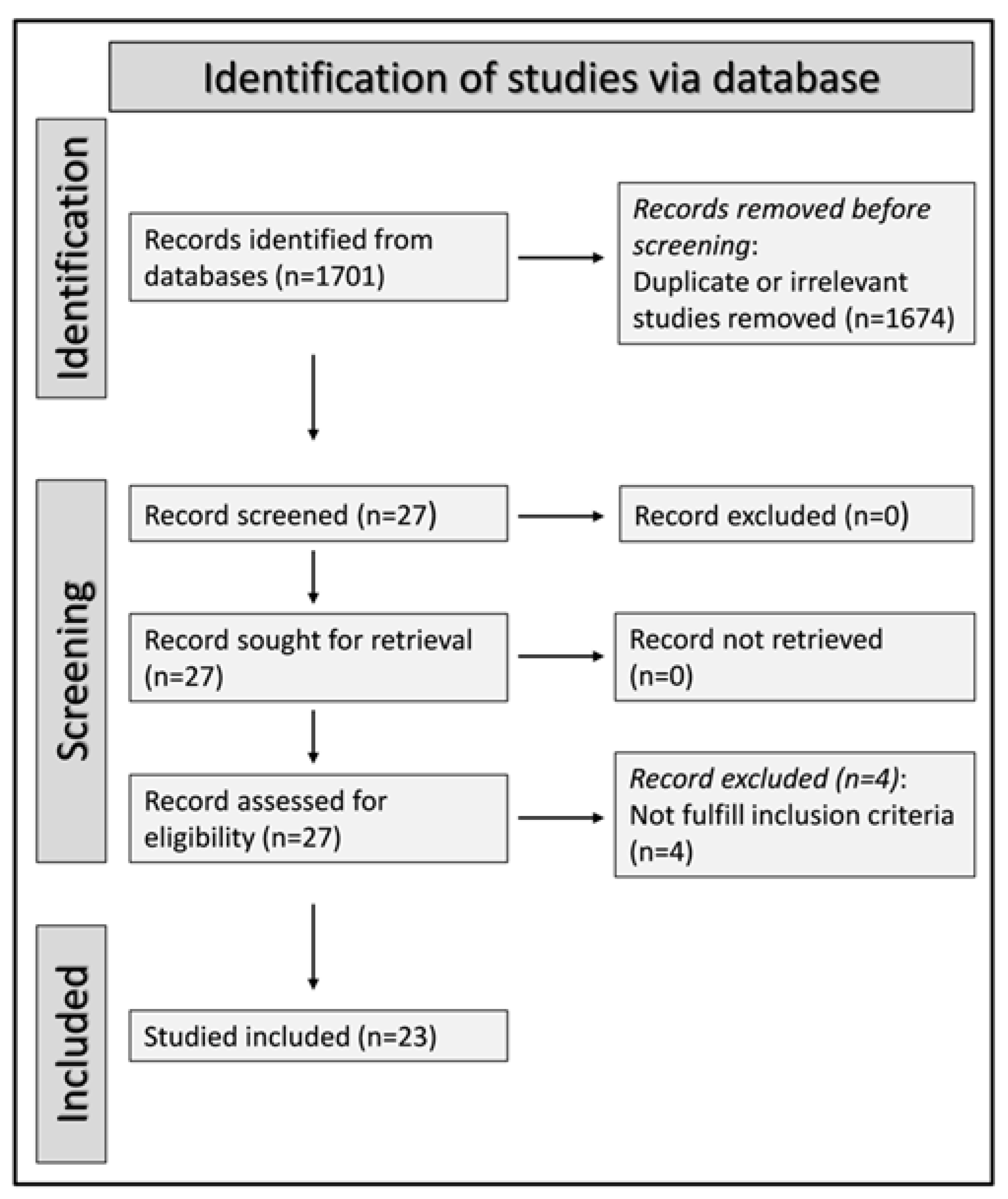
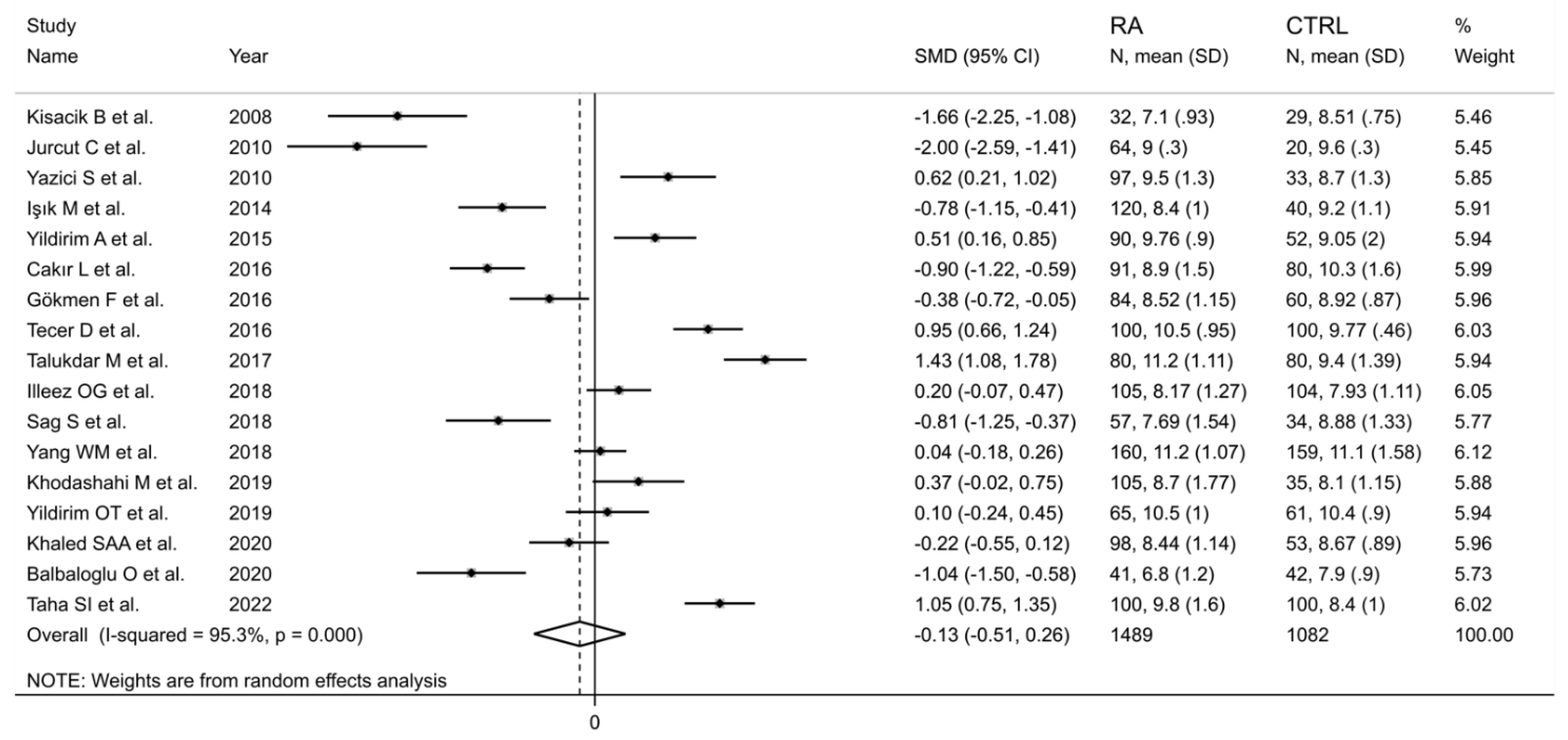
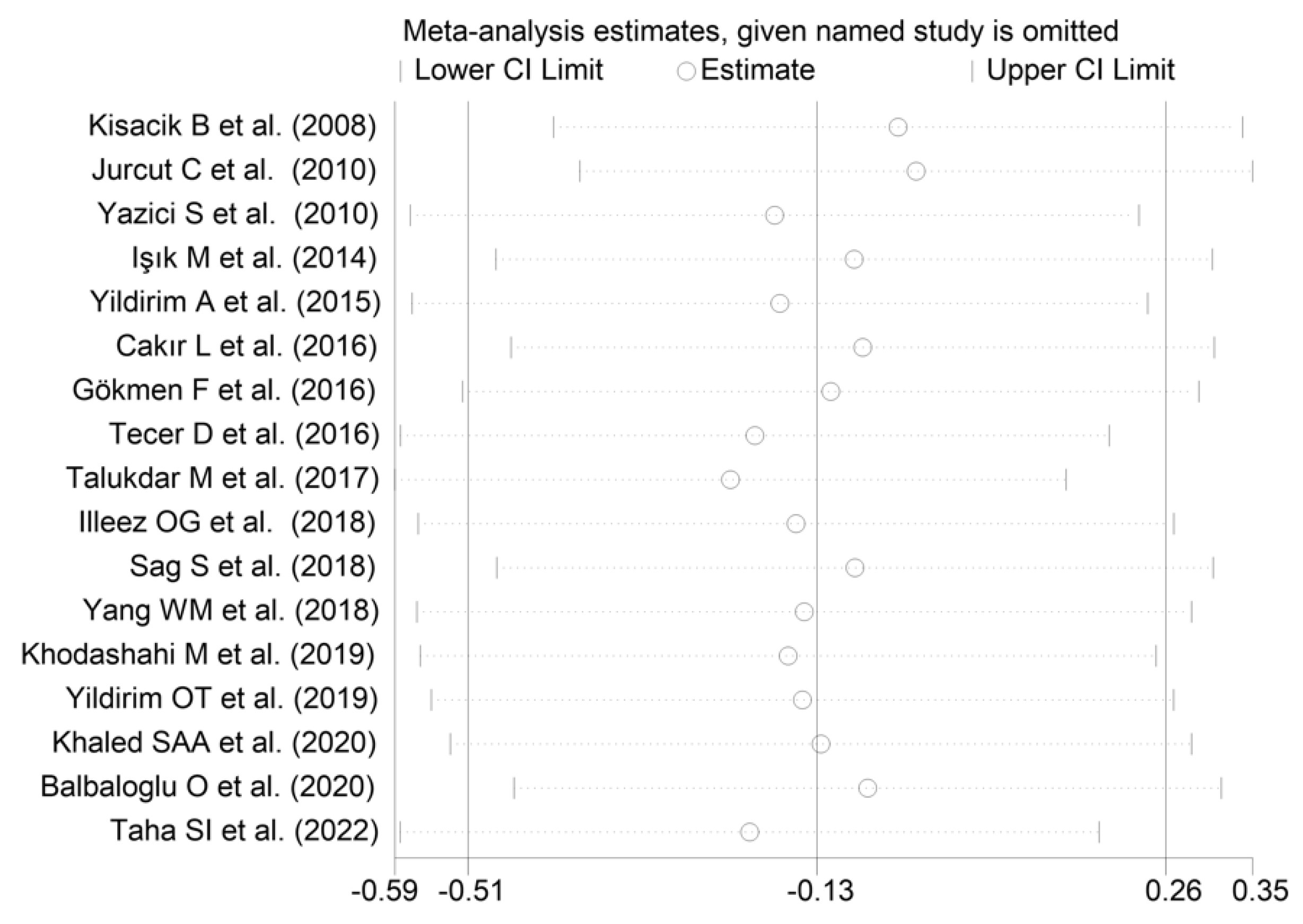

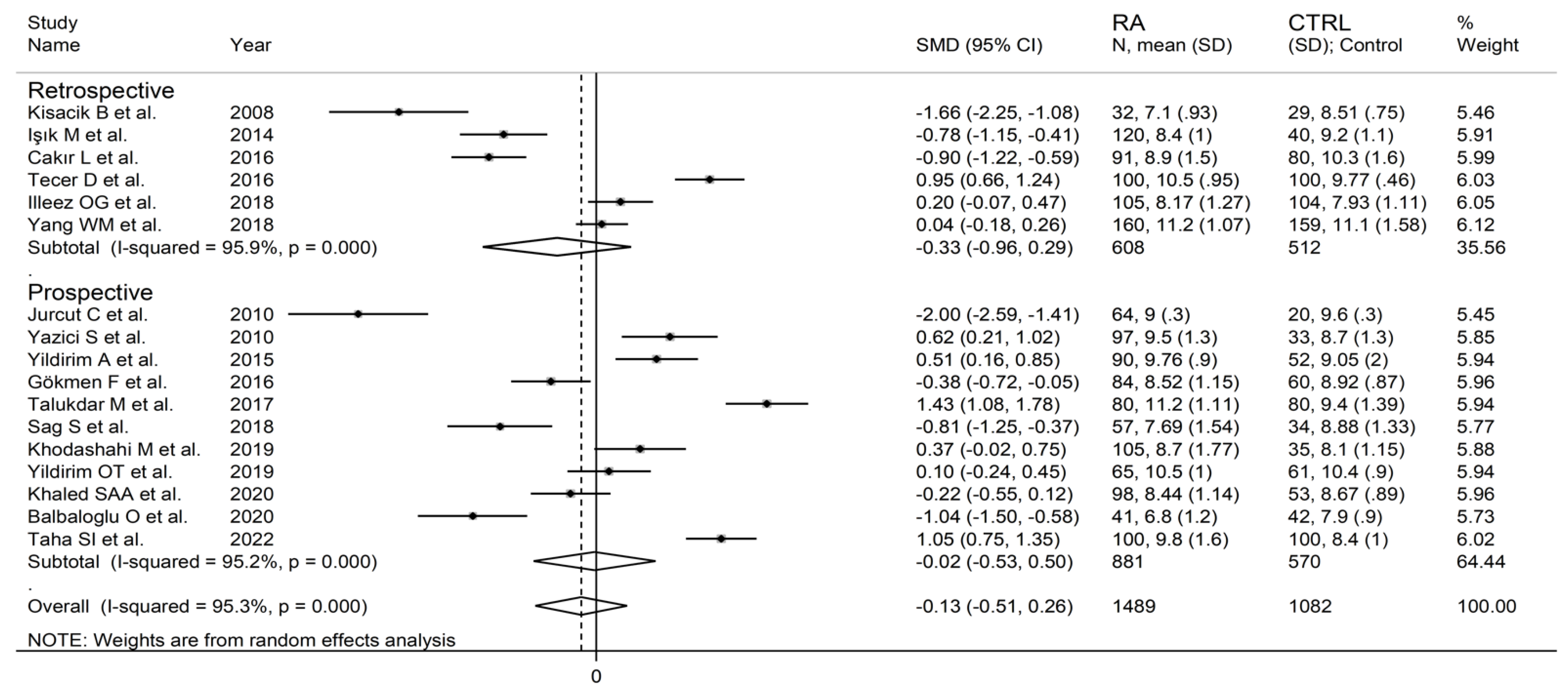

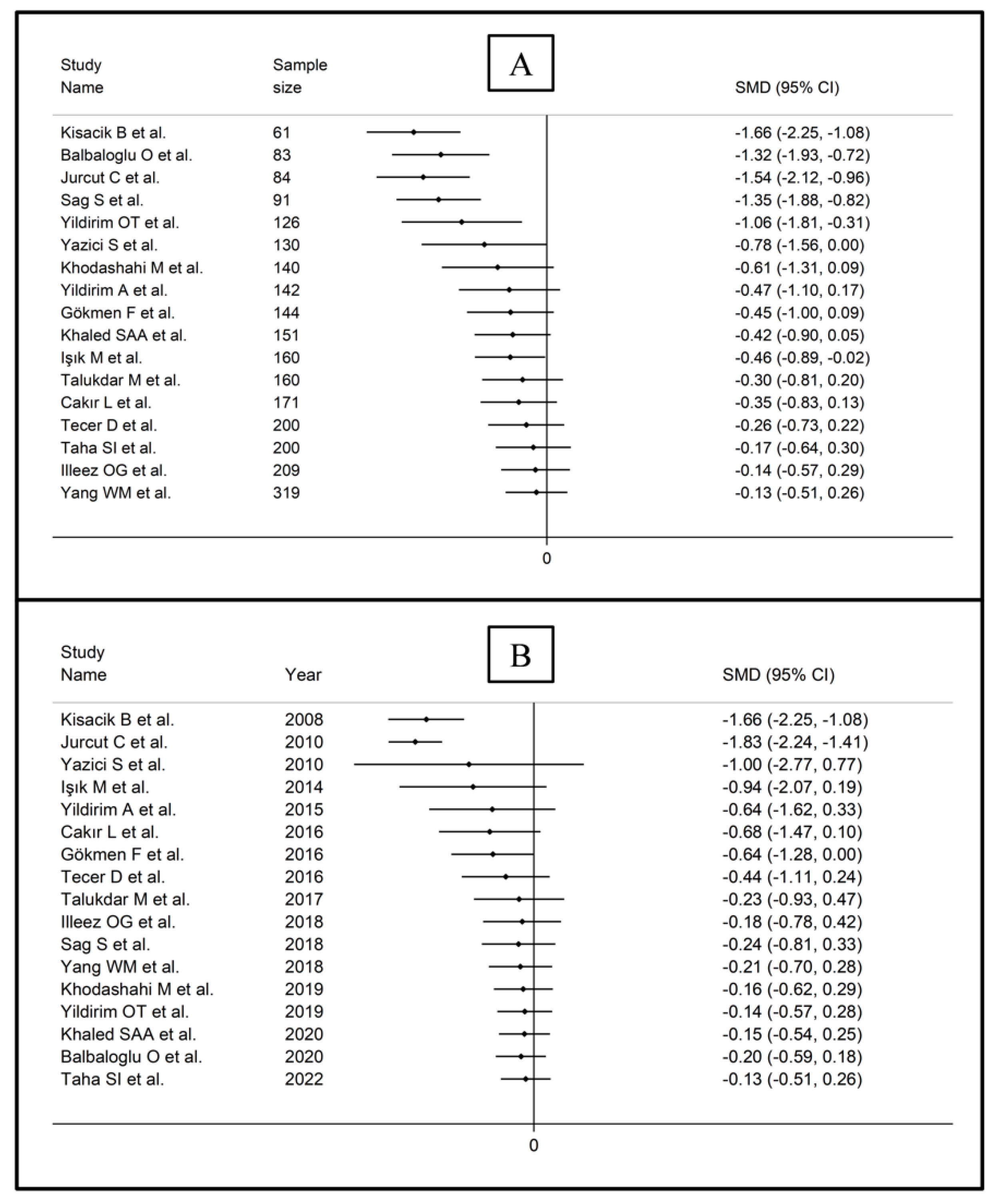
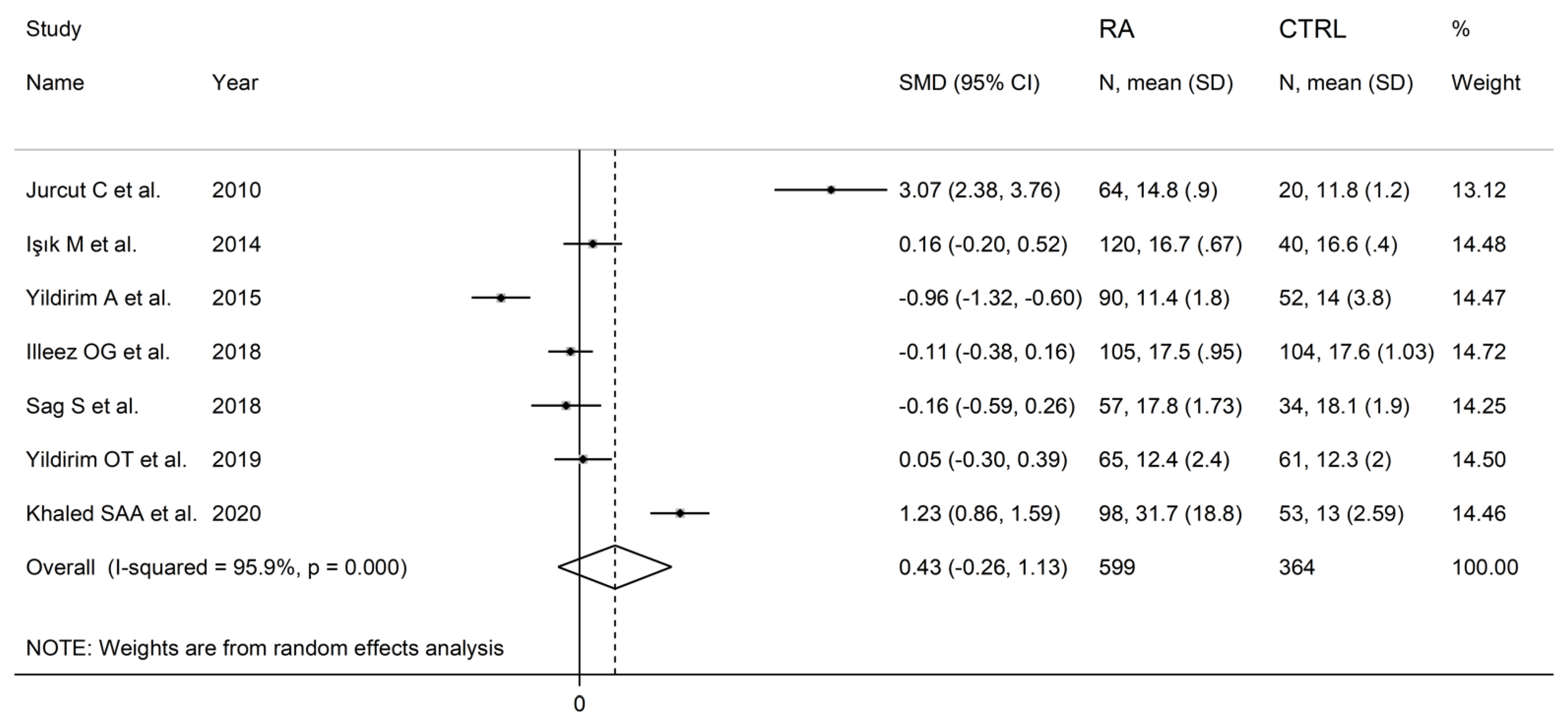
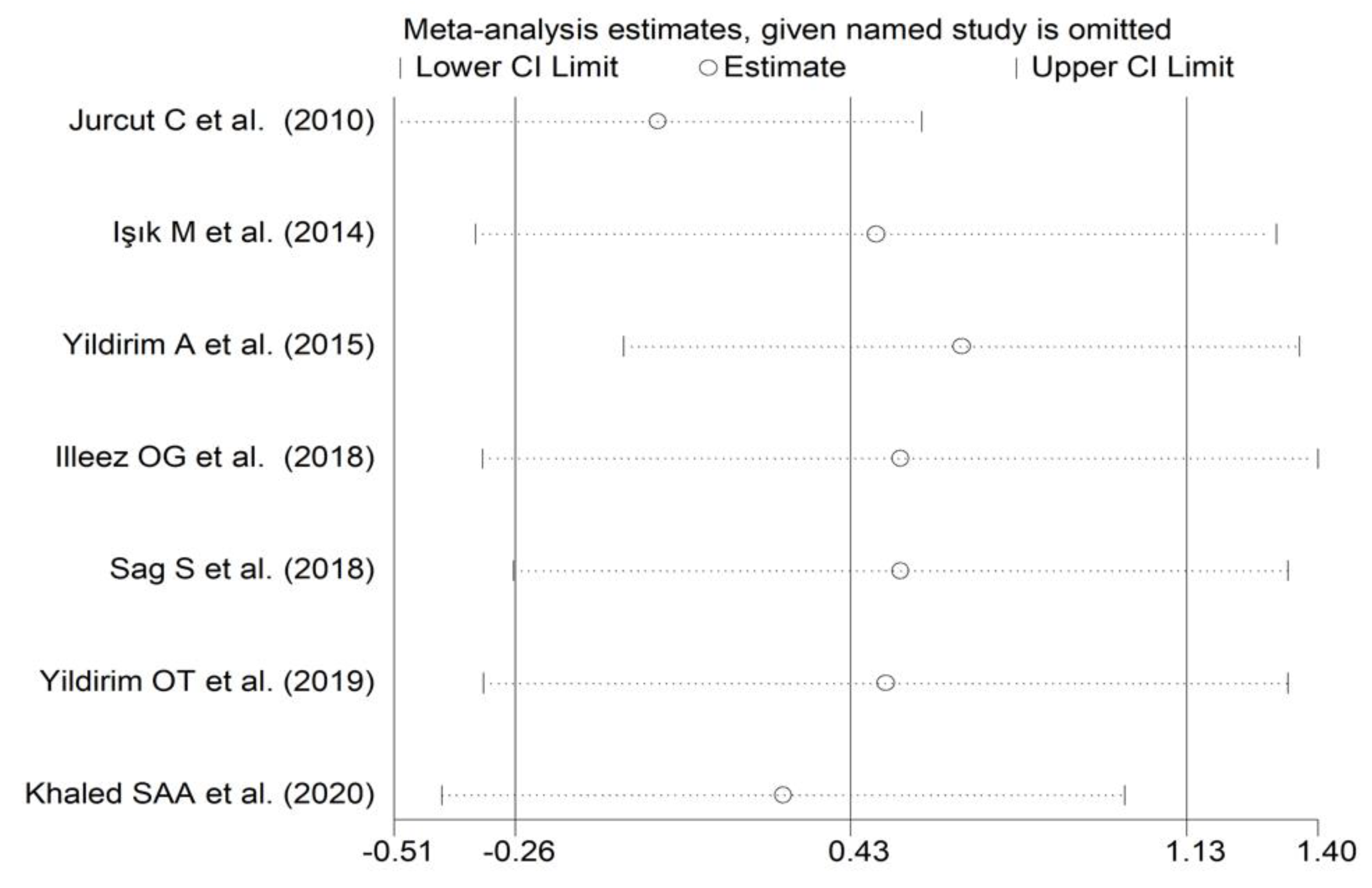


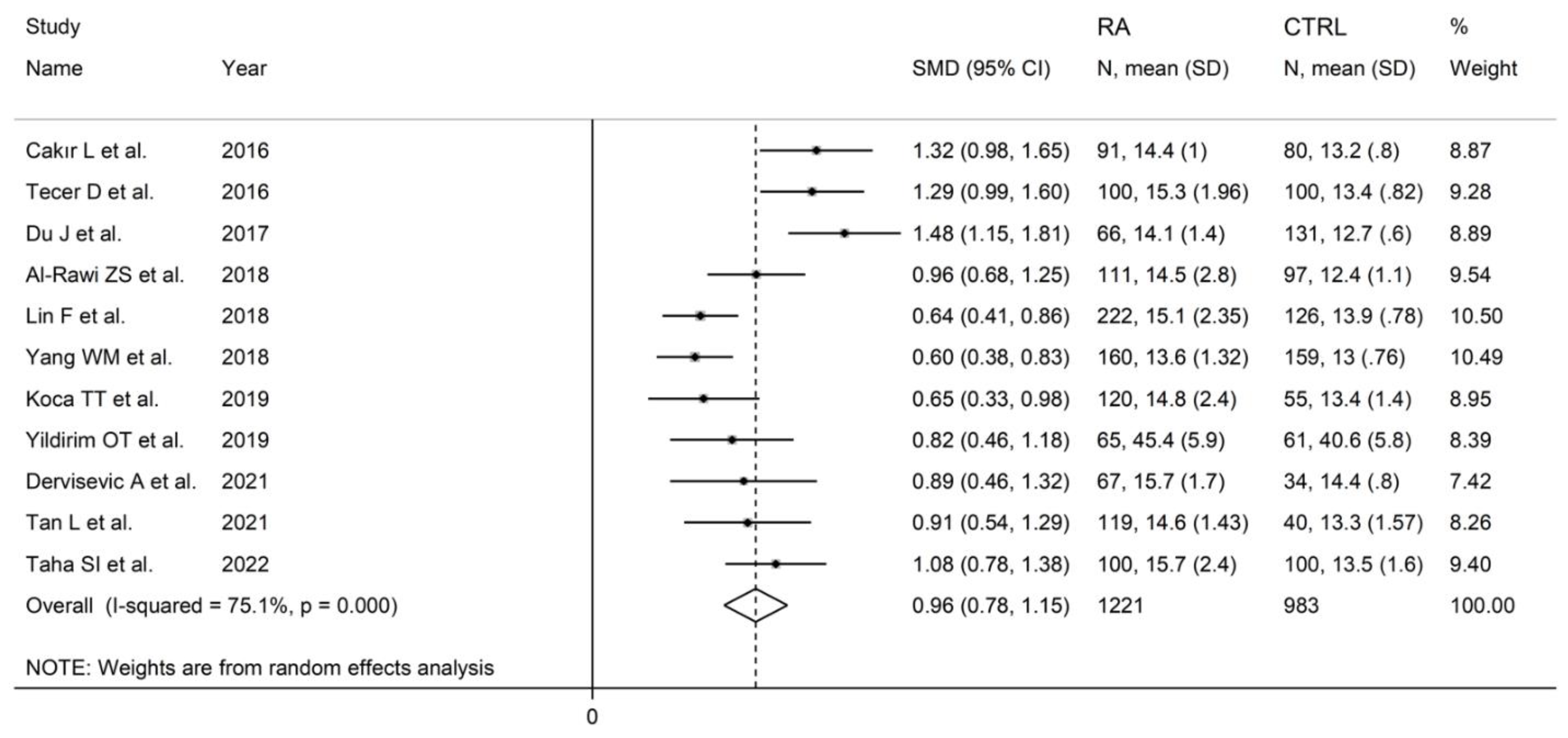
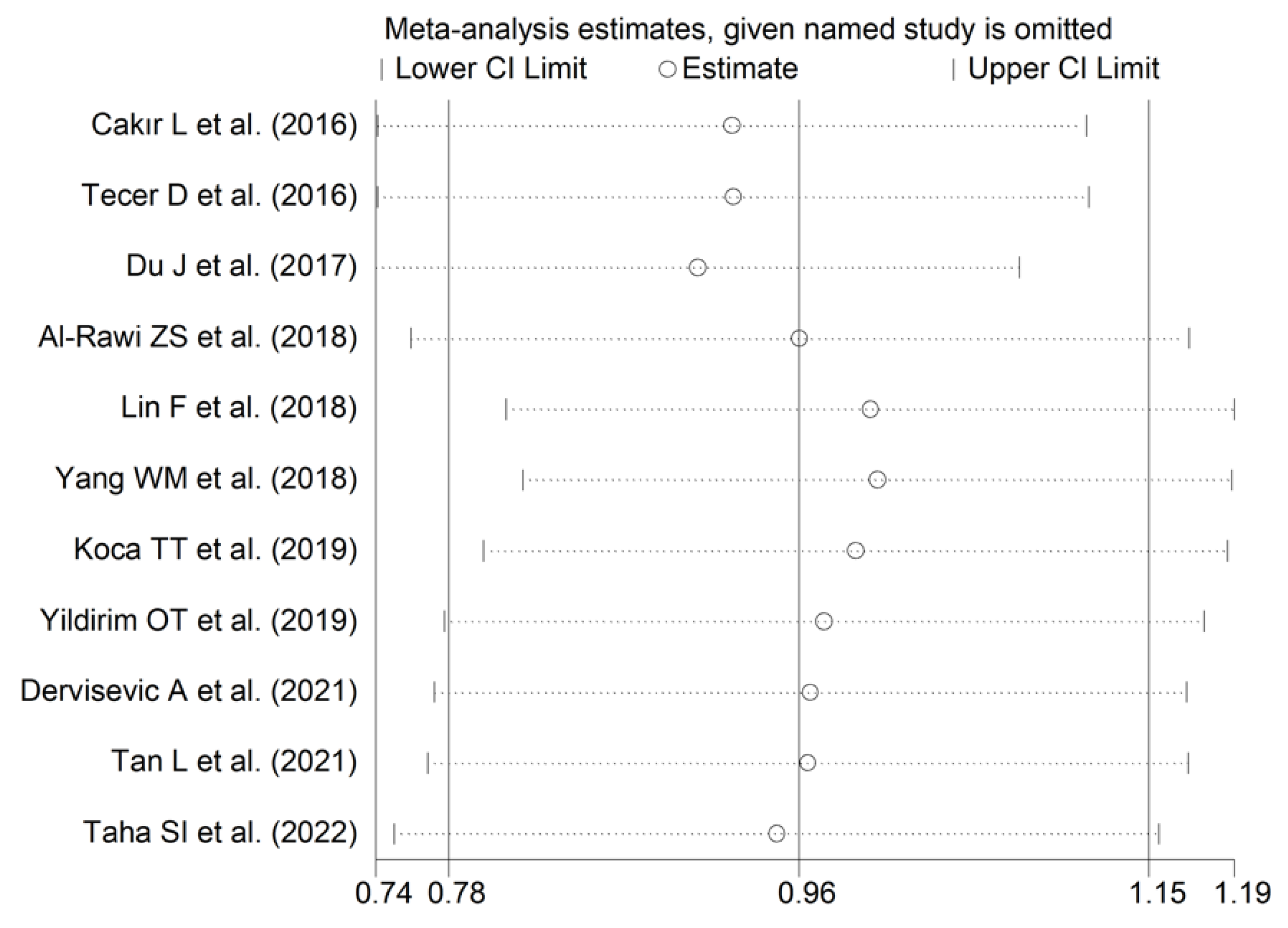

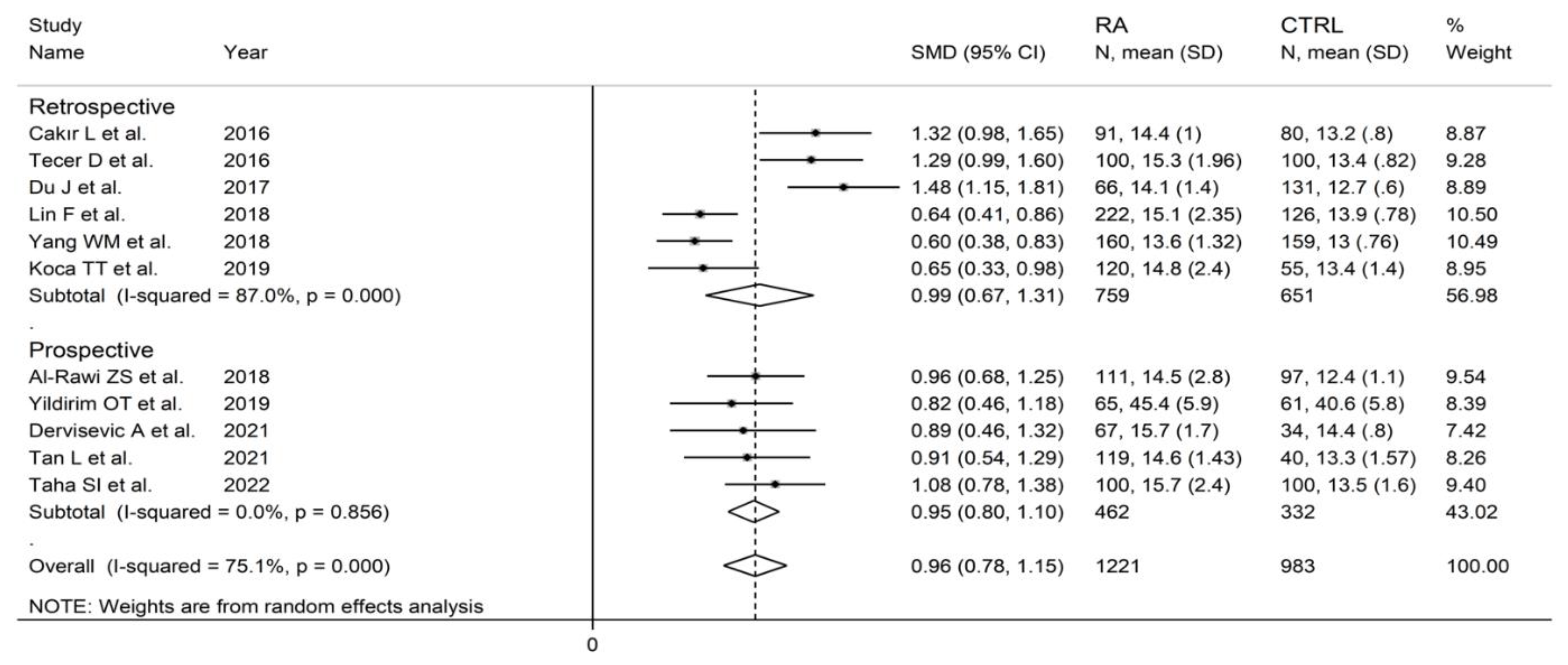
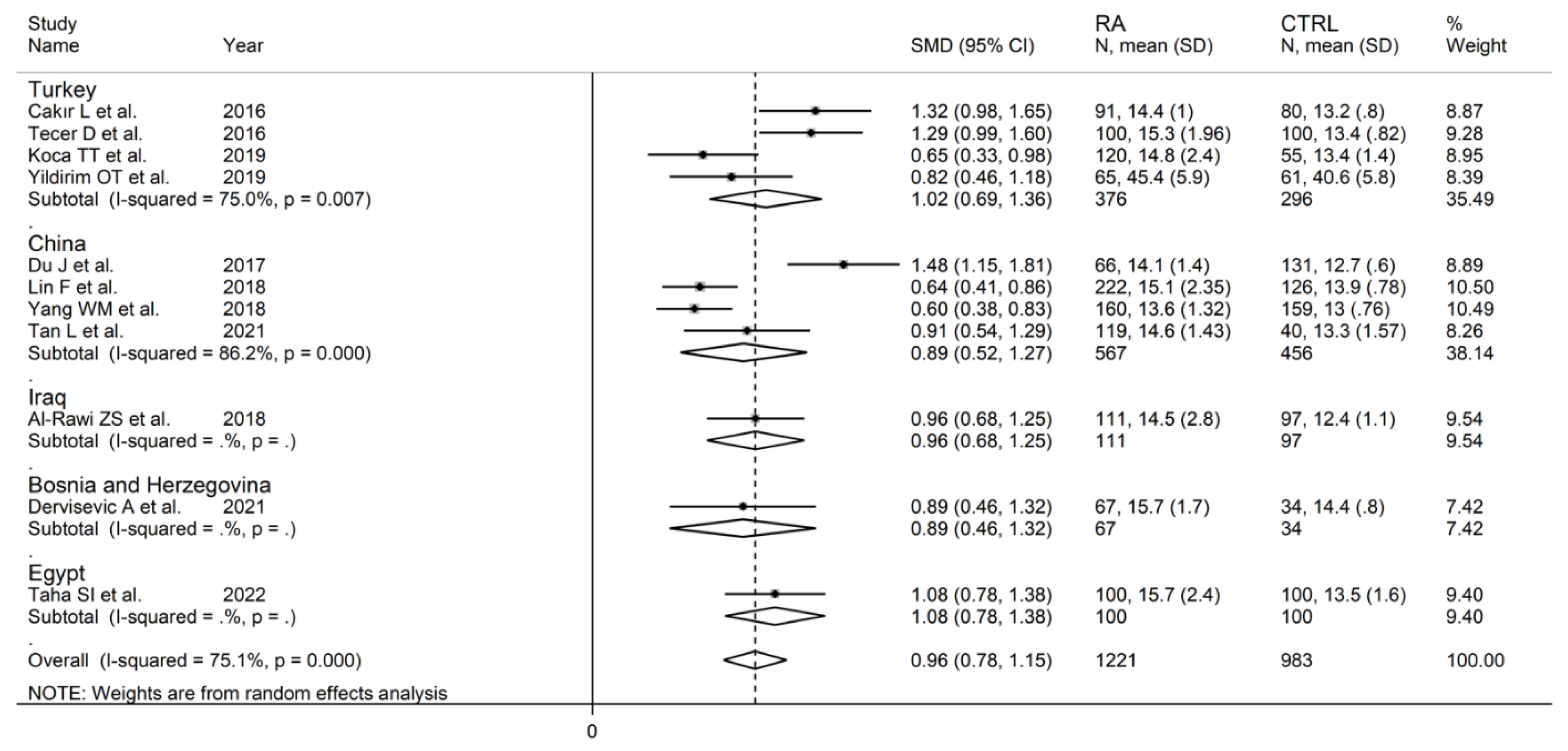
| Healthy Controls | Patients with Rheumatoid Arthritis | ||||||||
|---|---|---|---|---|---|---|---|---|---|
| First Author, Year, Country [Ref] | Study Design | n | Age (Years) M/F | MPV (fL) RDW (%) PDW (%) | n | Age (Years) M/F | MPV (fL) RDW (%) PDW (%) | CRP (mg/dL) | ESR (mm/h) |
| Kisacik B, 2008, Turkey [28] | R | 29 | 5/24 | 8.5 ± 0.7 NR NR | 32 | 49 7/25 | 7.1 ± 0.9 NR NR | 5.37 | 55 |
| Jurcut C, 2010, Romania [29] | P | 20 | 62 NR | 9.6 ± 0.3 NR 11.8 ± 1.2 | 64 | 56 NR | 9.0 ± 0.3 NR 14.8 ± 0.9 | NR | NR |
| Yazici S, 2010, Turkey [30] | P | 33 | 48 9/24 | 8.7 ± 1.3 NR NR | 97 | 51 19/78 | 9.5 ± 1.3 NR NR | 13.9 | 50 |
| Işık M, 2014, Turkey [31] | R | 40 | 54 12/28 | 9.2 ± 1.1 NR 16.6 ± 0.4 | 120 | 54 39/81 | 8.4 ± 1.0 NR 16.7 ± 0.7 | 13 | 35 |
| Yildirim A, 2015, Turkey [32] | P | 52 | 46 13/39 | 9.0 ± 2.0 NR 14.0 ± 3.8 | 90 | 47 21/69 | 9.8 ± 0.9 NR 11.4 ± 1.8 | 12.9 | 29 |
| Cakır L, 2016, Turkey [33] | R | 80 | 58 27/53 | 10.3 ± 1.6 13.2 ± 0.8 NR | 91 | 53 17/64 | 8.9 ± 1.5 14.4 ± 1.0 NR | NR | NR |
| Gökmen F, 2016, Turkey [34] | P | 60 | 51 16/44 | 8.9 ± 0.9 NR NR | 84 | 55 20/64 | 8.5 ± 1.1 NR NR | 1.5 | 32 |
| Tecer D, 2016, Turkey [35] | R | 100 | 58 5/95 | 9.8 ± 0.5 13.4 ± 0.8 NR | 100 | 58 5/95 | 10.5 ± 0.9 15.3 ± 2.0 NR | 10.5 | 26 |
| Du J, 2017, China [36] | R | 131 | 43 47/84 | NR 12.7 ± 0.6 NR | 66 | 56 14/52 | NR 14.1 ± 1.4 NR | 10.1 | 35 |
| Talukdar M, 2017, India [37] | P | 80 | NR NR | 9.40 ± 1.39 NR NR | 80 | NR 20/60 | 11.20 ± 1.11 NR NR | NR | NR |
| Al-Rawi ZS, 2018, Iraq | P | 97 | 48 21/76 | NR 12.4 ± 1.1 NR | 111 | 47 13/98 | NR 14.5 ± 2.8 NR | NR | NR |
| Illeez OG, 2018, Turkey [39] | R | 104 | 49 31/73 | 7.9 ± 1.1 NR 17.6 ± 1.0 | 105 | 53 19/86 | 8.2 ± 1.3 NR 17.5 ± 0.9 | 0.8 | 31 |
| Lin F, 2018, China [40] | R | 126 | 45 15/111 | NR 13.8 ± 0.8 NR | 222 | 59 44/178 | NR 15.1 ± 2.3 NR | NR | NR |
| Sag S, 2018, Turkey [41] | P | 34 | 50 10/24 | 8.9 ± 1.3 NR 18.1 ± 1.9 | 57 | 53 11/46 | 7.7 ± 1.5 NR 17.8 ± 1.7 | NR | NR |
| Yang WM, 2018, China [42] | R | 159 | 54 51/108 | 11.1 ± 1.6 13.0 ± 0.8 NR | 160 | 53 49/111 | 11.2 ± 1.1 13.6 ± 1.3 NR | 21.3 | 50 |
| Khodashahi M, 2019, Iran [43] | P | 35 | 51 4/31 | 8.1 ± 1.1 NR NR | 105 | 50 11/94 | 8.7 ± 1.8 NR NR | 6.1 | 19 |
| Koca TT, 2019, Turkey [44] | R | 55 | 48 12/43 | NR 13.4 ± 1.4 NR | 120 | 51 22/98 | NR 14.8 ± 2.4 NR | 1.2 | 32 |
| Yildirim OT, 2019, Turkey [45] | P | 61 | 52 NR | 10.4 ± 0.9 40.6 ± 5.8 * 12.3 ± 2.0 | 65 | 55 NR | 10.5 ± 1.0 45.4 ± 5.9 * 12.4 ± 2.4 | NR | NR |
| Khaled SA, 2020, Egypt [46] | P | 53 | 49 NR | 8.7 ± 0.9 NR 13.0 ± 2.6 | 98 | 49 NR | 8.4 ± 1.1 NR 31.7 ± 18.8 | 18.2 | 52 |
| Balbaloglu O, 2020, Turkey [47] | P | 42 | 42 NR | 7.9 ± 0.9 NR NR | 41 | 46 NR | 6.8 ± 1.2 NR NR | 10.6 | 19 |
| Dervisevic A, 2021, Bosnia and Erzegovina [48] | P | 34 | 51 5/29 | NR 14.4 ± 0.8 NR | 67 | 55 4/63 | NR 15.7 ± 1.7 NR | 5.6 | NR |
| Tan L, 2021, China [49] | P | 40 | 51 9/31 | NR 13.3 ± 1.6 NR | 119 | 51 29/85 | NR 14.6 ± 1.4 NR | NR | NR |
| Taha SI, 2022, Egypt [50] | P | 100 | 73 49/51 | 8.4 ± 1.0 13.5 ± 1.6 NR | 100 | 67 19/81 | 9.8 ± 1.6 15.7 ± 2.4 NR | NR | NR |
| Study | Were the Criteria for Inclusion Clearly Defined? | Were the Subjects and Setting Described in Detail? | Was the Exposure Measured in a Valid Way? | Were Standard Criteria Used to Measure the Condition? | Were Confounding Factors Identified? | Were Strategies to Deal with Confounding Factors Stated? | Were the Outcomes Measured in a Valid Way? | Was Appropriate Statistical Analysis Used? | Risk of Bias |
|---|---|---|---|---|---|---|---|---|---|
| Kisacik [28] | Yes | Yes | Yes | Yes | No | No | Yes | Yes | High |
| Jurcut [29] | Yes | Yes | Yes | Yes | No | No | Yes | Yes | Low |
| Yazici [30] | Yes | Yes | Yes | Yes | No | No | Yes | Yes | Low |
| Işık [31] | Yes | Yes | Yes | Yes | No | No | Yes | Yes | Low |
| Yildirim [32] | Yes | Yes | Yes | Yes | No | No | Yes | Yes | Low |
| Cakır [33] | Yes | Yes | Yes | Yes | No | No | Yes | Yes | Low |
| Gökmen [34] | Yes | Yes | Yes | Yes | No | No | Yes | Yes | Low |
| Tecer [35] | Yes | Yes | Yes | Yes | No | No | Yes | Yes | Low |
| Du [36] | Yes | Yes | Yes | Yes | Yes | Yes | Yes | Yes | Low |
| Talukdar [37] | Yes | Yes | Yes | Yes | No | No | Yes | Yes | Low |
| Al-Rawi [38] | Yes | Yes | Yes | Yes | No | No | Yes | Yes | Low |
| Illeez [39] | Yes | Yes | Yes | Yes | No | No | Yes | Yes | Low |
| Lin [40] | Yes | Yes | Yes | Yes | No | No | Yes | Yes | Low |
| Sag [41] | Yes | Yes | Yes | Yes | No | No | Yes | Yes | Low |
| Yang [42] | Yes | Yes | Yes | Yes | Yes | Yes | Yes | Yes | Low |
| Khodashahi [43] | Yes | Yes | Yes | Yes | No | No | Yes | Yes | Low |
| Koca [44] | Yes | Yes | Yes | Yes | No | No | Yes | Yes | Low |
| Yildirim [45] | Yes | Yes | Yes | Yes | No | No | Yes | Yes | Low |
| Khaled [46] | Yes | Yes | Yes | Yes | No | No | Yes | Yes | Low |
| Balbaloglu [47] | Yes | Yes | Yes | Yes | No | No | Yes | Yes | Low |
| Dervisevic [48] | Yes | Yes | Yes | Yes | No | No | Yes | Yes | Low |
| Tan [49] | Yes | Yes | Yes | Yes | No | No | Yes | Yes | Low |
| Taha [50] | Yes | Yes | Yes | Yes | No | No | Yes | Yes | Low |
Publisher’s Note: MDPI stays neutral with regard to jurisdictional claims in published maps and institutional affiliations. |
© 2022 by the authors. Licensee MDPI, Basel, Switzerland. This article is an open access article distributed under the terms and conditions of the Creative Commons Attribution (CC BY) license (https://creativecommons.org/licenses/by/4.0/).
Share and Cite
Zinellu, A.; Mangoni, A.A. Platelet and Red Blood Cell Volume Indices in Patients with Rheumatoid Arthritis: A Systematic Review and Meta-Analysis. Diagnostics 2022, 12, 2633. https://doi.org/10.3390/diagnostics12112633
Zinellu A, Mangoni AA. Platelet and Red Blood Cell Volume Indices in Patients with Rheumatoid Arthritis: A Systematic Review and Meta-Analysis. Diagnostics. 2022; 12(11):2633. https://doi.org/10.3390/diagnostics12112633
Chicago/Turabian StyleZinellu, Angelo, and Arduino A. Mangoni. 2022. "Platelet and Red Blood Cell Volume Indices in Patients with Rheumatoid Arthritis: A Systematic Review and Meta-Analysis" Diagnostics 12, no. 11: 2633. https://doi.org/10.3390/diagnostics12112633
APA StyleZinellu, A., & Mangoni, A. A. (2022). Platelet and Red Blood Cell Volume Indices in Patients with Rheumatoid Arthritis: A Systematic Review and Meta-Analysis. Diagnostics, 12(11), 2633. https://doi.org/10.3390/diagnostics12112633








